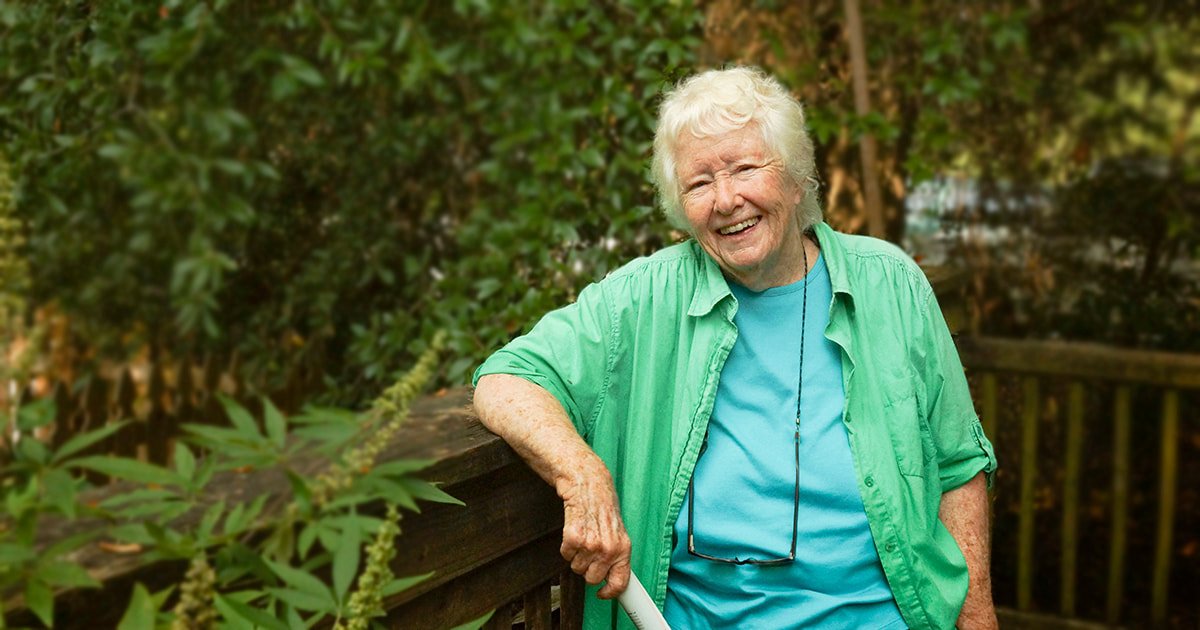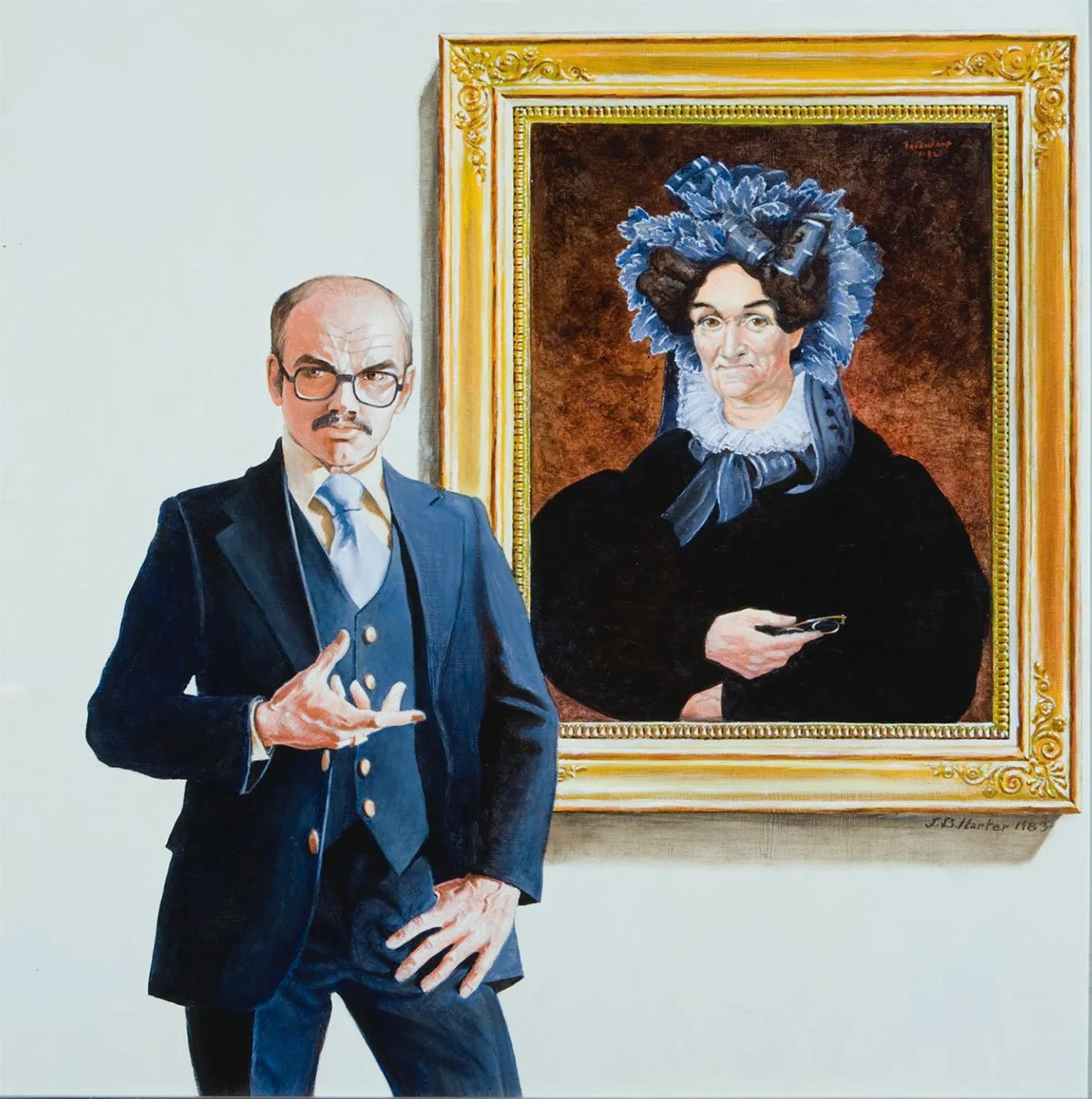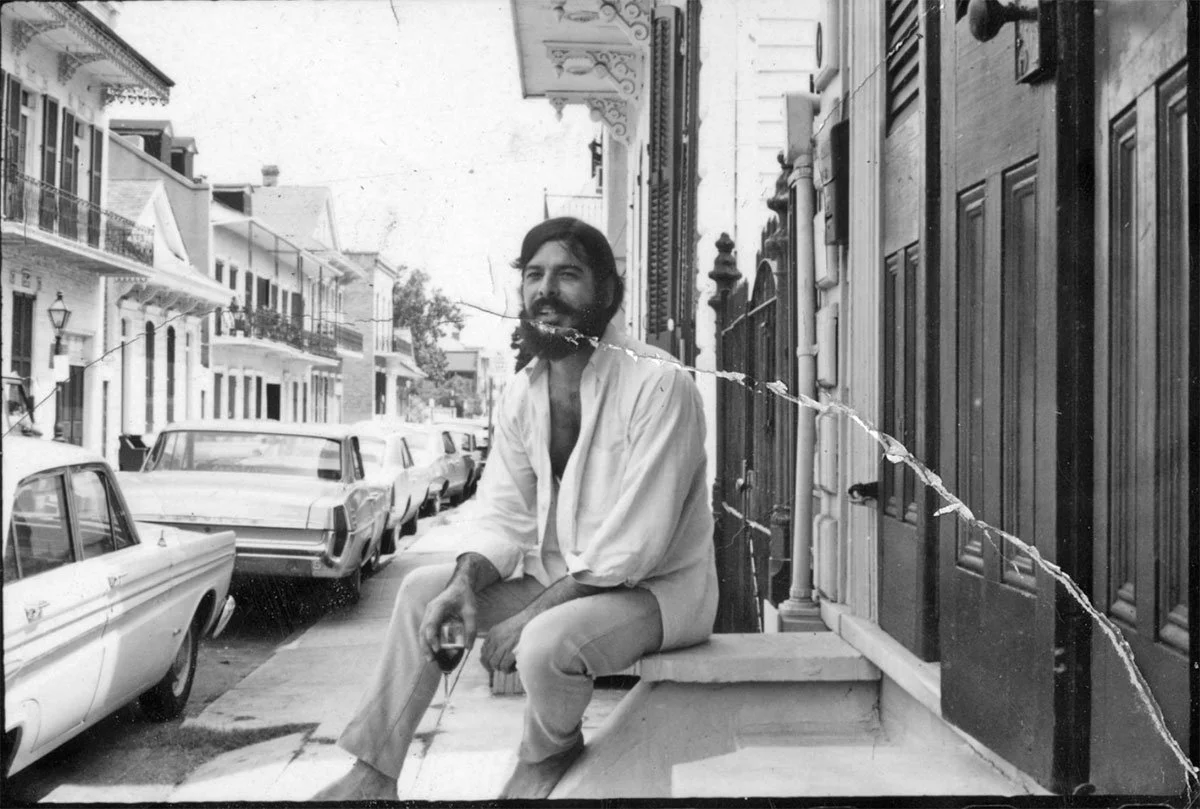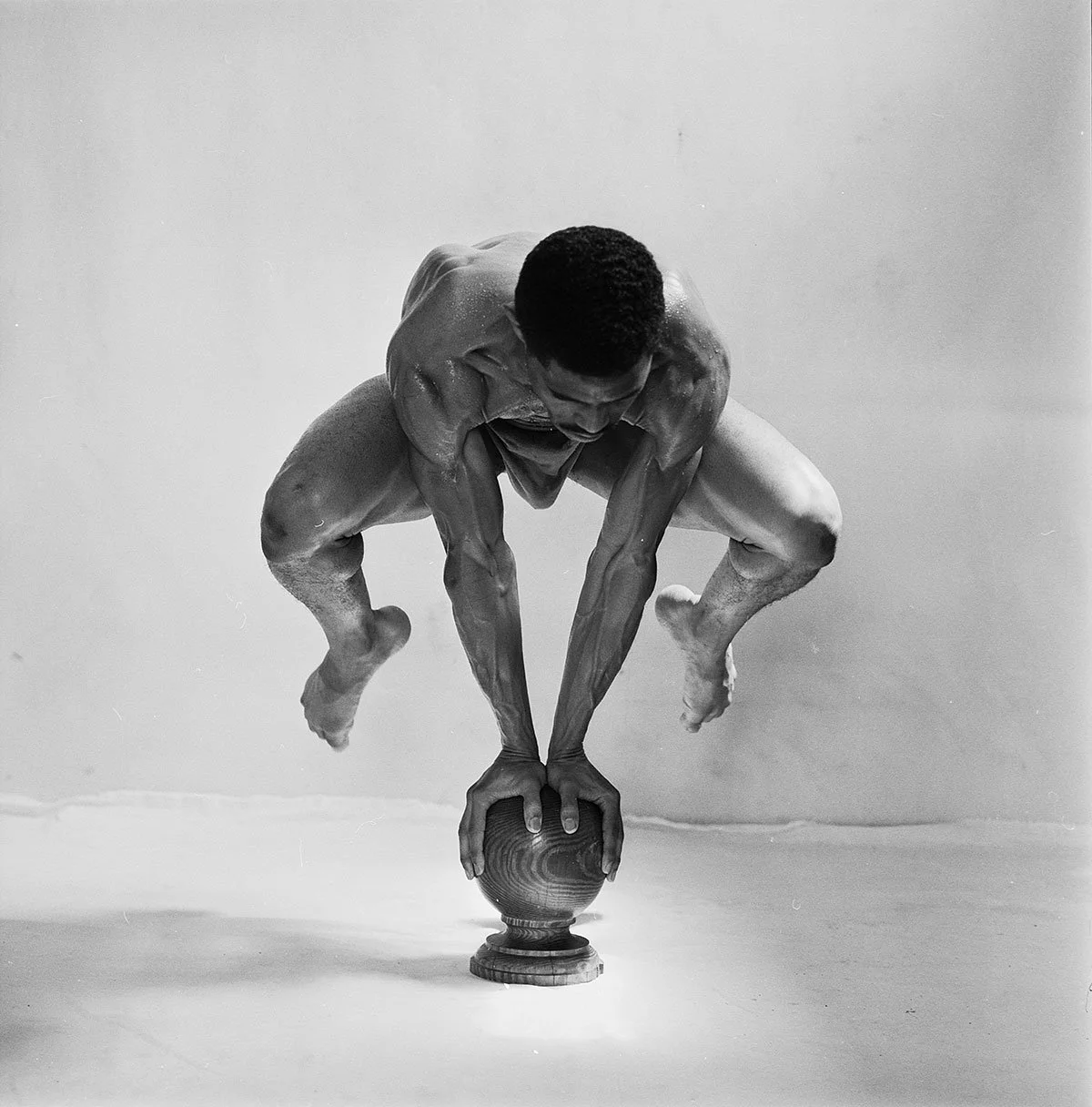Celebrating Queer Art
Storm’s Oppstilt, by John Burton Harter, courtesy of the John Burton Harter Foundation
May 2025A four-day multi-media series of events honors legendary Louisiana LGBTQ+ artists - and introduces the work of emerging ones.
~ by Claude Summers
Queer Art – which might be described as encompassing both the work of LGBT+ individuals and their representation in the visual arts – is both mainstream and marginalized. It constitutes a rich cultural legacy, but one that has often been denigrated and suppressed.
Even when queer artists achieve canonical status in the art world, their work is often subjected to homophobic denial and erasure or else robbed of its specificity in efforts to render it "universal.”
Because of New Orleans’ reputation as a Southern Bohemia where people of different ethnicities and races and proclivities can find and build their own communities, it’s attracted artists, writers and intellectuals of all stripes. The French Quarter especially has been a magnet for LGBT people in search not only of their own kind but also of their cultural and artistic heritage.
LGBT+ Archives Project
The LGBT+ Archives Project of Louisiana was organized in 2013 to promote and encourage the protection and preservation of materials that chronicle the culture and history of the LGBT community in Louisiana. Each June, to celebrate Pride Month, the organization sponsors a series of educational and public awareness events.
This year, the focus is on Louisiana Queer artists. The program will be presented at various venues in New Orleans over four days, from June 5 to June 8. The events will include film screenings, panel discussions, art exhibits, and an artists’ fair. All the events are free and open to the general public.
Prominent queer artists celebrated by the LGBT+ Archives Project this year are Barbara Scott, John Burton Harter, and George Dureau, but the project will also highlight younger artists and filmmakers as well.
Barbara Scott
On June 5, at the Dodwell House (1519 Esplanade Avenue) at 7pm, former French Quarter resident Barbara Scott will be honored with the Archives' Stewart Butler/Alfred Doolittle Award for Contributions to Queer History.
In a 2019 French Quarter Journal profile entitled "Go Your Own Way," Frank Perez observed that Scott "blazed her own trail as a politician, restaurateur, hôtelier, artist, preservationist, gerontologist, feminist, and social justice warrior."
Barbara Scott, photo by Ellis Anderson
Perez’s profile of Scott opens with a thunderclap:
It's election season, and the popular restaurant-owner-turned-political-candidate is fielding questions from reporters while drawing beer for thirsty patrons in her St. Peter Street establishment.
The Republican is running to represent the French Quarter and the surrounding area in the state legislature.
She is also a feminist lesbian with a platform of legalizing marijuana and ending legal discrimination against Blacks, gays and women.
The candidate is Barbara Scott. The year is 1971.
A 1971 ad for Barbara Scott.
Frank Perez, executive director of LGBT+ Archives of LA, says Scott was singled out for the award this year for a number of reasons.
“She’s often been neglected and overlooked,” he says, “But her contributions still reverberate today. For instance, the fact that she was the first openly gay political candidate in Louisiana is certainly significant – and still has resonance, especially in today’s political climate.
Scott talking about her work at an exhibit at Studio Waveland, in Waveland, MS, 2019. Photo courtesy Studio Waveland.
One of Barbara Scott’s Goddess sculptures, photo courtesy Barbara Scott
Perez also notes that Scott was the inspiration behind the long-running feminist magazine in New Orleans, Distaff, which published lesbian content. And Scott’s restaurant, The Fatted Calf on St. Peter Street, was a community nexus for queer Quarterites in the ‘70s and ‘80s. Best known as a sculptor in her later years, Scott’s work will be exhibited during the presentation.
Editor's note: Read more about Scott’s sculptures in this PDF. Scott, who now lives in Pass Christian, Mississippi, isn’t able to attend the events, but made a statement in a brief video message.
“We have things to be proud of,” she asserts in the video. “And that’s the acceptance we’ve gained, the joy we’ve given… I’m loving you for being who you are. I’m loving you for being creative and honest in your lives. Loving you for giving the world art and music far beyond your number.”
John Burton Harter
A 1992 self-portrait of John Burton Harter, one of the artists whose work will be featured in the Louisiana Queer Arts celebration. THNOC, 2008.0218.8
Self-portrait by John Burton Harter, THNOC, 2008.0218.8
After the presentation to Scott at the Dodwell House, a panel discussion will focus on the work of John Burton Harter (1940—2002), who documented the richness of gay experience in his artwork. Panelists will include Ron Joullian, Noel Twilbeck, Brian Sands, Sean Svetlik, and Bradley Sumrall.
Like Scott, Harter was born in Mississippi but spent most of his life in New Orleans. He began his career in 1967 as an assistant curator at the Historic New Orleans Collection and then moved to the Louisiana State Museum, where, after a series of promotions, he was Director of Collections when he retired in 1991.
Although he had earlier earned recognition as a painter of abstract works, still-lifes, and landscapes reflecting the vivid colors of the American Southwest, it was only after the death of his mother in 1996 that he began exhibiting his homoerotic work.
Upon his publication of a collection of paintings and drawings entitled Encounters with the Nude Male in 1997, he wrote, "I have been turning out works of gay-oriented art for nearly thirty years, most of which almost no one has seen."
One of Harter’s extraordinary landscapes, THNOC, 2008.0218.7
Sage Wash Near Gallup, New Mexico, oil painting, 1993, courtesy the John Burton Harter Foundation
Harter's life ended tragically when he was murdered on March 13, 2002 in his home.
A second book of Harter's art, The Drawings of J. B. Harter (2003), was published posthumously.
The New Orleans Contemporary Arts Center honored his work with an exhibition, "The Culture of Queer: A Tribute to J. B. Harter," that opened on July 22, 2005. The show featured, in addition to Harter's drawings and paintings, works by Robert Mapplethorpe and Andy Warhol and several Louisiana artists, including George Dureau and Roberto Rincon.
Helenus 2nd Position, oil painting, 1993, courtesy the John Burton Harter Foundation
The exhibit was scheduled to run until September 11, coinciding with Southern Decadence, the New Orleans festival celebrating LGBT culture. However, the show was closed early by the catastrophe of Hurricane Katrina. Happily, the artwork escaped damage, and the exhibition reopened as planned at the Leslie-Lohman Gay Art Foundation in New York City in May 2006.
Since then, Harter's work – especially his figure studies, as well as his still lifes and depictions of gay camaraderie and affection – has been celebrated in publications and exhibits throughout the country.
In his will, Harter established the John Burton Harter Foundation to ensure the visibility of his art and to fulfill his creative vision. The Foundation supports exhibits, catalogues, and publications through grants to nonprofit organizations. Among the foundation's recent projects was the exhibition and catalogue of A Tale of Two Cities: Patrick Angus in New York and J. B. Harter in New Orleans. The foundation has also sponsored panel discussions in connection with the exhibit in New York, New Orleans, and Los Angeles.
George Dureau
George Dureau in the French Quarter, The Historic New Orleans Collection, 215.0293.2.10.6.1
On June 6, at the Williams Research Center (410 Chartres), at 6pm, the LGBT+ Archive Project will sponsor the screening of the 2023 documentary, George Dureau: New Orleans Artist. The film will be introduced by filmmakers Sergio Andres Lobo-Navia and Jarret Lofstead.
On June 6, at the Williams Research Center (410 Chartres), at 6:00 p.m., the LGBT+ Archive Project will sponsor the screening of the 2023 documentary, George Dureau: New Orleans Artist.
The film focuses on Dureau's photography and his models. Featuring rarely seen archival footage, photos, and interviews with Dureau’s friends and family, it explores race, sexuality, and class through the works of one of New Orleans's most iconic artists.
One of George Dureau’s live model photographs, Historic New Orleans Collection, gift of Donald Dureau, 2015.0293.2.7.3.1
In addition, on Saturday, June 7, there will be an exhibit of Dureau's photography (on loan from the Arthur Roger Gallery) at the Marigny Opera House (725 Ferdinand St.) from 11am to 6pm.
Photographer Robert Mapplethorpe, whose work was influenced by George Dureau. Photo by George Dureau, 1979, THNOC, 215.0293.2.16.4
Although Dureau's work has been exhibited in galleries and museums worldwide, and he even lived briefly in New York in 1966, he was quintessentially a New Orleanian. He was born in the city in 1930 and, except for brief absences, he lived here until his death in 2014.
The symbiotic relationship between Dureau's work and New Orleans is best explained by the late Kenneth Holditch, who observed some time ago that Dureau's art is "entwined with that mixture of contradictory elements that constitutes the carnal atmosphere of his native city.”
Perhaps this accounts to some extent for the paradoxes so distinctly a part of his best work: the joyful and painful, the beautiful and ugly, the spiritual and sensual, and most significant of all, the real in sharp juxtaposition to that which is vividly imagined. Dureau looks at life in its grandeur and grossness, and his keen eye and sure hand do not wink or tremble at either extreme.
Although Dureau acknowledged the influence of the abstract expressionists in the use of color, he steadfastly--even stubbornly--insisted on creating narrative and representational art, even when representational art was unfashionable. His most persistent subject is the human figure, whether presented in narrative contexts, mythological fantasies, portraits, and self-portraits, clothed or nude, painted or photographed.
George Dureau self-portrait, THNOC, Gift of Donald Dureau, 2015.0293.2.10.5.12
Artists Fair and Exhibition
The Marigny Opera House, photo by Ellis Anderson
The Marigny Opera House is also the site of an Artists Fair and Exhibition, from 11:30am to 6pm on June 7th. The event, curated by Ryan Leitner, will showcase the work of younger queer artists from across the state: Jaime Cantrell, Vernell Dunams, Josiah Gagosian, Hope Hickman, Dr. Liz Johnston-Dupre, Kristi Knipe, Colin Robinson, Taylor Sacco, Ryne Stoned, Romy Thompson, and Bobby White.
Curator Ryan Leitner calls the exhibition “a celebration of the diverse identities we have here in New Orleans, setting the stage for visibility and conversations around our beautiful and strong communities.”
Later in the day, from 6pm - 7:30pm, a panel discussion will take place at the Marigny Opera House. The panel, which will include Arthur Roger, Meg Turner, and David Campbell, will explore the history of queer art in Louisiana.
Filmmakers
The final segment in the LGBT+ Archive Project's program on queer art will take place at the Broad Theatre (636 N. Broad St.) on Sunday, June 8, from 1pm to 3pm.
Entitled "Sneak Peeks at Queer Films Currently in Production," the event will feature three filmmakers who will introduce their current projects and show clips from them:
Valda Lewis's eagerly awaited documentary From Where We Stood: AIDS and the Culture Wars
Joel Gray's feature film, inspired by the 1973 UP Stairs Lounge fire, The Last Sunday in June
Lasse Lau and Flo Maaks's documentary Bachelor's Only, about the legendary French Quarter bar, Dixie's Bar of Music.
Author’s note:
The study and appreciation of art history is always a continual process of discovery and recovery. Hence, it is appropriate in this report on the celebration of Louisiana Queer Artists by the indispensable LGBT+ Archives Project to call attention to a queer Louisiana artist who is not included in the celebration but who is nevertheless featured in this edition of the French Quarter Journal: Philip Core, Torchbearer for Artistic Freedom.
Core is the subject of Bethany Ewald Bultman's fascinating article that brings attention to a New Orleans artist who was celebrated in 1980s London but became the victim of a homophobic backlash that almost entirely erased his reputation. Bultman's article helps restore the reputation of a significant talent whose New Orleans childhood left an indelible impression on his work.
The Complete Schedule of Louisiana Queer Arts 2025
Thursday, June 5 – Sunday, June 8
LGBT+ Archives Project of Louisiana
Multiple locations
The focus of this year’s LGBT+ Archives Project of Louisiana is Louisiana Queer Arts, with programming around current working artists and the history of LGBT+ artists in Louisiana. See art exhibitions, an artists’ fair, panel discussions, and film screenings at multiple locations. All events free and open to the public.
🏳️🌈🏳️🌈🏳️🌈🏳️🌈
Thursday, June 5: 7pm
Annual Membership Meeting and Program Launch
followed by
Panel Discussion: The life, work, and art of John Burton Harter
Dodwell House, 1519 Esplanade Avenue
Includes the presentation of the annual Stewart Butler / Alfred Doolittle Award for Contributions to Queer History to recipient Barbara Scott.
Following the award ceremony, panelists discuss the work of prolific artist John Burton Harter. This event features an exhibit of original works by Harter on loan from the Faerie Playhouse.
🏳️🌈🏳️🌈🏳️🌈🏳️🌈
Friday, June 6: 6pm
Film Screening: George Dureau: New Orleans Artist
Williams Research Center, 410 Chartres Street
Filmmakers Sergio Andres Lobo-Navia and Jarret Lofstead introduce their new documentary on influential visual artist and photographer George Dureau (1930–2014).
🏳️🌈🏳️🌈🏳️🌈🏳️🌈
Saturday, June 7: 11am–6pm
Artists’ Fair and Exhibition
Marigny Opera House, 725 St. Ferdinand Street
Featuring the work of Louisiana artists Jaime Cantrell, Vernell Dunams, Josiah Gagosian, Hope Hickman, Dr. Liz Johnston-Dupre, Kristi Knipe, Colin Robinson, Taylor Sacco, Ryne Stoned, Romy Thompson, and Bobby White. Also, see an exhibit of George Dureau photographs on loan from the Arthur Roger Gallery.
🏳️🌈🏳️🌈🏳️🌈🏳️🌈
Saturday, June 7: 6–7:30pm
Panel Discussion: Historical Perspectives on Louisiana Queer Art
Marigny Opera House, 725 St. Ferdinand St.
Panelists include Arthur Roger, Meg Turner, and David Campbell.
🏳️🌈🏳️🌈🏳️🌈🏳️🌈
Sunday, June 8: 1–3pm
Sneak peeks of queer films currently in production
Broad Theatre, 636 N. Broad Street
Valda Lewis, Joey Gray, and Lasse Lau and Flo Maak introduce and show clips of current works.


















